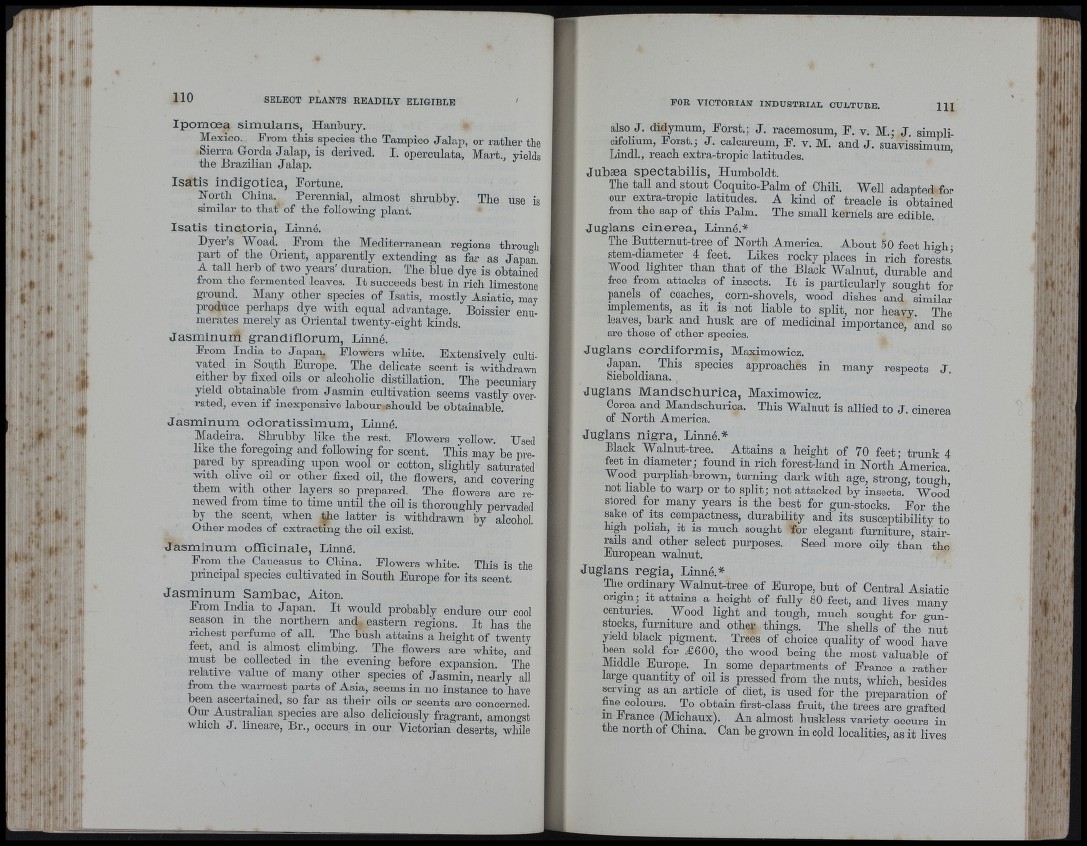
It'
Pill ,
Jfl
Ipomoea simulans, Hanbury.
Mexico. From this species the Tampico Jalap, or rather the
Sierra Gorda Jalap, is derived. I. operculata. Mart., vields
the Brazilian Jalap.
Isatis indigotica, Fortune.
North China. Perennial, almost shrubby,
similar to that of the following plant.
The use is
Isatis tinctoria, Linné.
Dyer’s Woad. From the Mediterranean regions through
part of the Orient, apparently extending as far as Japan
A tall herb of two years’ duration. The blue dye is obtamed
from the fermented leaves. I t succeeds best in rich limestone
ground. Many other species of Isatis, mostly Asiatic, may
produce perhaps dye with equal advantage. Boissier enumerates
merely as Oriental twenty-eight kinds.
Jasminum grandiflorum, Linné.
From India to Japan. Flowers white. Extensively cultivated
in South Europe. The delicate scent is withdrawn
either by fixed oils or alcoholic distillation. The pecuniary
yield obtainable from Jasmin cultivation seems vastly overrated,
even if inexpensive labour should be obtainable.
Jasminum odoratissimum, Linné.
Madeira. Shrubby like tbe rest. Elowers yellow. Used
like tbe foregoing and following for scent. This may be prepared
by spreading upon wool or cotton, slightly saturated
with olive oil or other fixed oil, the flowers, and coverhw
them with other layers so prepared. The flowers are re'^
newed from time to time nntü the oil is thoroughly pervaded
by the scent, when the latter is withdrawn by alcohol,
Other modes of extracting the oil exist.
Jasminum officinale, Linné.
Erom the Caucasus to China. Elowers white. This is the
principal species cultivated in South Europe for its scent.
Jasminum Sambac, Aiton.
Eromliyiia to Japan. I t would probably endure our cool
season in tbe northern and eastern regions. I t has the
richest perfume of all. The bush attains a height of twenty
feet, and is almost^ climbing. The flowers are white, and
must be collected in tlie evening before expansion. ’ The
relative value of many other species of Jasmin, nearly all
from the wannest parts of Asia, seems in no instance to have
been ascertained, so far as their oils or scents are concerned.
Onr Australian species are also deliciously fragrant, amongst
which J . lineare, Br., occurs in our Victorian deserts, wlflle
also J. didymum, Forst.; J . racemosum, E. v. M.; J simpli-
cifolium, Forst.; J . calcarenm, E. v. M. and J . suavissimum
Lindl, reach extra-tropic latitudes. ’
Jubaea spectabilis, Humboldt.
The tall and stout Coquito-Palm of Chili. Well adapted for
our extra-tropic latitudes. A kind of treacle is obtained
from the sap of this Palm. The small kernels are edible.
Juglans cinerea, Linné.*
The Butternut-tree of North America. About 50 feet bmh •
stem-diameter 4 feet. Likes rocky places in rich forests’
Wood lighter than that of the Black Walnut, durable and
free from attacks of insects. I t is particularly sought for
panels of coaches, _ corn-sbovels, wood dishes and similar
implements, as it is not liable to split, nor heavy. The
leaves, bark and busk are of medicinal importance, and so
are those of other species,
Juglans cordiformis, Maximowicz.
Japan. Tbis species approaches in many respects J
Sieholdiana. I
Juglans Mandschurica, Maximowicz.
Corea and Mandschurica. This Walnut is allied to J. cinerea
of North America,
Juglans nigra, Linné.*
Black Walnut-tree. Attains a height of 70 feet; trunk 4
feet in diameter; found in rich forest-land in North America.
Wood purplish-brown, turning dark with age, strong, tou<yh*
not liable to warp or to split; not attacked by insects. Wood
stored for many years is the best for gun-stocks. Eor the
sake of its compactness, durability and its susceptibility to
high polish, it is much sought for elegant furniture, stair-
mds and other select purposes. Seed more oily than the
European walnut.
Juglans regia, Linné.*
The ordinary Walnut-tree of Europe, but of Central Asiatic
origm; it attains a height of fully 80 feet, and lives manv
centuries. Wood light and tough, much sought for o-un-
stocks, furniture and other things. The shells of the '’nut
^ eld black pigment. Trees of choice quality of wood have
been sold for £600, the wood being tbe most valuable of
Middle Europe. In some departments of France a rather
large quantity of oil is pressed from the nuts, which, besides
servmg as an article of diet, is used for tbe preparation of
fine colours. To obtain first-class fruit, the trees are grafted
m France (Michaux), An almost huskless variety occurs in
the north of China. Can be grown in cold localities, as it lives
r
Ml
i\
, 11
^ Í
'■> I
.i: . I
Î ,